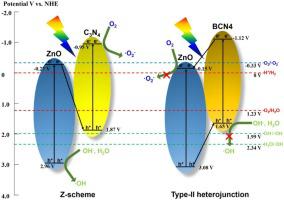Applied Catalysis B: Environment and Energy ( IF 20.2 ) Pub Date : 2020-09-09 , DOI: 10.1016/j.apcatb.2020.119538 Donghyung Kim , Kijung Yong

|
Heterojunction photocatalysts are very promising for solar hydrogen production due to their high efficiency in photo-driven charge generation and separation. A C3N4/ZnO heterostructure nanocomposite harvests a wide range of solar light from the UV and visible regions and retains a high redox potential due to its Z-scheme band structure. However, since both C3N4 and ZnO have sufficiently high conduction band energies to drive hydrogen photoreduction, a type II heterojunction is more beneficial for enhancing the hydrogen production efficiency in the current system. In this study, we first demonstrated the charge transfer mechanism switching from the Z-scheme to type II by simple boron (B) doping of C3N4/ZnO. The doping of C3N4 with low-electronegativity boron increases its Fermi level by 0.4?V, making it even higher than that of ZnO. As a result, the Fermi level alignment of B-doped C3N4 with ZnO causes a reversed band bending direction at the C3N4/ZnO junction. The resultant charge transfer switching from the Z-scheme (C3N4/ZnO) to type II (B-doped C3N4/ZnO) was confirmed by UPS and ESR analysis. Type II B-doped C3N4/ZnO shows a stable, drastic increase in the photocatalytic hydrogen evolution rate, approximately 2.9 times higher than that of undoped C3N4/ZnO. The decreased bandgap energy of B-doped C3N4/ZnO also contributes to an additional improvement in efficiency through enhanced light harvesting. Our work presents a simple but effective strategy to design highly capable heterojunction photocatalysts via charge transfer switching with a doping method.
中文翻译:

硼掺杂引起的C 3 N 4 / ZnO光催化剂从Z方案到II型的电荷转移转换,以增强光催化氢的产生
异质结光催化剂因其在光驱动电荷产生和分离方面的高效率而非常有望用于太阳能制氢。AC 3 N 4 / ZnO异质结构纳米复合材料从UV和可见光区域收集了广泛的太阳光,并由于其Z型谱带结构而保留了高氧化还原电势。然而,由于C 3 N 4和ZnO都具有足够高的导带能量来驱动氢光还原,所以II型异质结对于提高当前系统中的氢产生效率更有利。在这项研究中,我们首先证明了通过C 3 N的简单硼(B)掺杂将电荷转移机制从Z方案转换为II型4 /氧化锌。低电负性硼掺杂C 3 N 4可使费米能级提高0.4?V,甚至高于ZnO。结果,B掺杂的C 3 N 4与ZnO的费米能级对准在C 3 N 4 / ZnO结处引起反向的带弯曲方向。通过UPS和ESR分析确认了所得电荷从Z方案(C 3 N 4 / ZnO)转换为II型(B掺杂C 3 N 4 / ZnO)的转移。II型B掺杂的C 3 N 4/ ZnO显示出稳定的,急剧的光催化氢释放速率增加,比未掺杂的C 3 N 4 / ZnO高约2.9倍。B掺杂的C 3 N 4 / ZnO的带隙能量的降低还通过增强光的收集来进一步提高效率。我们的工作提出了一种简单而有效的策略,即通过使用掺杂方法的电荷转移开关来设计高性能的异质结光催化剂。











































 京公网安备 11010802027423号
京公网安备 11010802027423号